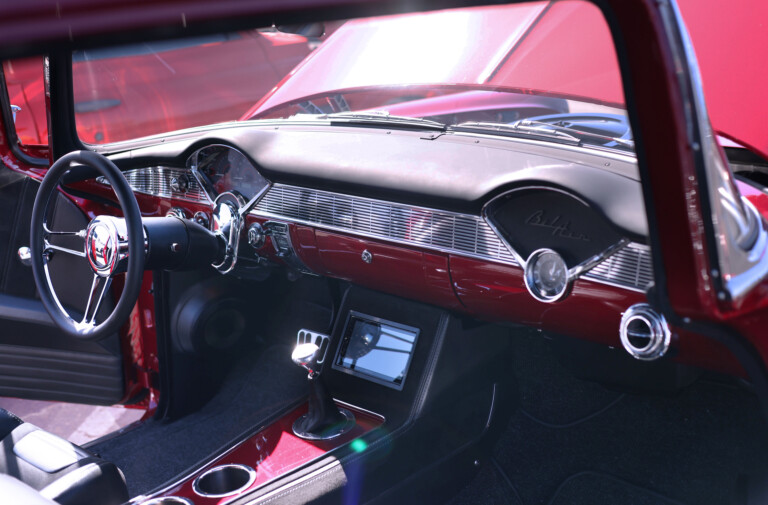Words and Photos by Richard Holdener
What is the better choice for your 5.0L Ford, carburetion or injection? The question is a simple one, but the answer somewhat less so. Obviously, we would have to be slightly more specific and determine exactly which carbureted and EFI combos we were discussing, to say nothing of what we mean by the generic word “better.” Is all carburetion for the 5.0L Ford better than all injection? Not likely, but nor is the opposite true. I guess the phrase “different strokes for different folks” applies here.
The carbureted 302 contingent that grew up in the late ’60s and early ’70s (actually through the mid ’80s) might feel differently than the 5.0L Ford owners that cut their performance teeth on modern fuel injection. For Ford fans that predate the 5.0L, the complexity of fuel injection doesn’t compare to the simplicity of a good, old-fashioned carburetor.
In spite of the fact the carb guys are carb guys and EFI guys are EFI guys, that didn’t stop us from running a comparison between the two. If nothing else, it should give the two camps even more to argue about. Before we could start testing, we needed to source a few important components, including both induction systems and a suitable test motor.
The test motor was easy enough, as we already had a 5.0L Ford (302 for you carb guys) on hand and ready to run. Much more than a just a stocker, the early 5.0L was recently yanked from an Explorer that wound up in a local LKQ Pic-a-Part. We retained the short block, after stripping off the GT-40 induction system and matching iron heads. Naturally, the stock cam was replaced by a more aggressive variety, in this case a COMP XE274HR grind. The XE274HR delivered a .555/.565 lift split, a 224/232-degree duration split, and 112-degree lsa. This was about as wild a cam as we dared run with the available piston-to-valve clearance.
Once we had the new COMP cam in place, we turned our attention to the cylinder heads. The GT-40 heads on our early Explorer motor were upgraded with a set of 170cc, 11R heads from Trick Flow Specialties. Don’t let the 170cc port volumes throw you; they were perfect for the little 302, and the new 11R heads offered some impressive features. We loved the billet external appearance, but for power, the heads featured full CNC porting (including intake, exhaust, and combustion chambers). Further improving flow were revised valve angles of 11 and 13 degrees (intake and exhaust) and a 2.02/1.60 stainless steel valve package.
Equally important for power were the 56cc combustion chambers, which helped to increase the static compression ratio over the 65cc GT-40 heads. The stock 5.0L (and GT-40 Cobra) featured 61cc chamber heads, but even these did not compare to the small-chamber TFS 11R heads. The heads were shipped with a hydraulic roller spring package that allowed us to safely rev the motor to 6,500 rpm. Covering the 1.6-ratio roller rockers and hardened pushrods was a set of Speedmaster aluminum valve covers.
With our test mule complete, we installed the first of the two induction systems, starting with carburetion. The TFS heads were topped with a polished, dual-plane Eliminator intake. Ideal for any street and even most street/strip applications, the dual-plane design promised (and delivered) a broad torque curve combined with the ability to pull hard up to and beyond 6,000 rpm. The Eliminator intake was combined with a Holley 650 Ultra XP carb, but not before adding an MSD billet distributor and a set of Hooker 1 ¾-inch, long-tube headers.
Run with the dual-plane intake and carburetor, the modified 302 Ford produced 394 hp at 6,300 rpm and 370 lb-ft of torque at 4,300 rpm. Torque production with the dual plane exceeded 350 lb-ft all the way out to 5,400 rpm, and the horsepower curve remained strong past 6,600 rpm. After running the dual plane and carburetor, off it came to make room for the fuel-injected configuration.

To ensure we maximized the power potential of the EFI induction system, we dialed in the air/fuel and timing curves with this FAST XFI management system.

Run with the TFS EFI set up, the fuel-injected 5.0L Ford produced 391 hp and 372 lb-ft of torque. Though the peak numbers were very similar, the injected version offered more power from 4,700 rpm to 6,000 rpm, but fell off to the dual plane out to 6,600 rpm.
Since the 5.0L Ford was already blessed with a set of TFS 11R heads, we decided to make it a family affair by replacing the carburetion with an induction system from TFS, as well. Available in different guises for specific rpm ranges, we chose the Street Heat upper and lower intake. The Street heat featured 12.2-inch runners designed to provide ample torque and power up to 6,000 rpm. If this sounds a lot like the dual-plane intake, you have been paying close attention. Feeding the Street Heat was a 75mm throttle body from Accufab, while fuel was supplied by a set of Accel injectors. Tuning the injected combination was a FAST XFI management system.

302 Ford-Speedmaster Dual Plane vs TFS Street Heat EFI
Prior to the test, the 5.0L was upgraded with a COMP cam, TFS 11R heads and 1.6-ratio roller rockers. First run with the Speedmaster Eliminator intake and Holley carb, the modified 5.0L produced 394 hp at 6,300 rpm and 370 lb-ft of torque at 4,300 rpm. Obviously, the combination worked well together, as the 302 just missed reaching the 40-hp mark. The TFS Street Heat EFI upper and lower intake offered nearly identical peak numbers, checking in with 391 hp and 372 lb-ft of torque, but the curves show injection offered more power from 4,700 rpm to 6,000 rpm. The dual plane held the advantage both below 4,000 rpm and above 6,100 rpm.
After dialing in the air/fuel and timing curves, the fuel-injected 5.0L produced 391 hp at 5,900 rpm and 372 lb-ft of torque at 4,200 rpm. Looking at the power curves (see graphs), we see that, despite similar peak numbers, the injected combination offered sizable gains from 4,700 rpm to 6,000 rpm, but the carb combo pulled away on the big end. The dual plane also offered slightly more torque below 4,000 rpm, so let’s get that party started — is the hot setup carburetion or injection?
Sources: LKQ, Lkqpickyourpart.com; ARP, Arp-bolts.com; COMP Cams, compcams.com; Holley/Hooker/Weiand, holley.com; MSD, Msdignition.com; Speedmaster, Speedmaster79.com; Trick Flow Specialties, trickflow.com




















